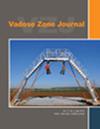Mapping spatiotemporal soil moisture in highly heterogeneous agricultural landscapes using mobile dual‐spectra cosmic‐ray neutron sensing
IF 2.8
3区 地球科学
Q3 ENVIRONMENTAL SCIENCES
引用次数: 0
Abstract
Abstract Accurate large‐scale soil moisture (SM) maps are crucial for catchment‐scale hydrological models used for water resource management and warning systems for droughts, floods, and wildfires. SM can be mapped by mobile cosmic‐ray neutron (CRN) systems of moderated detectors at homogeneous landscapes of similar soil and vegetation. In this study, we present a new approach for mobile CRN detection to perform to its full potential, where CRN measurements can also be converted to SM at heterogeneous landscapes. The approach is based solely on thermal and epithermal neutron datasets obtained from mobile dual‐spectra CRN detection, combined with theoretical developments using a particle transport model. For each measurement point, the land cover type is identified using the thermal‐to‐epithermal (T/E) ratio, and the relevant neutron‐count‐to‐soil‐moisture conversion function is estimated from CRN stations located at the main land cover types in the catchment. With this approach, the requirement of collecting 100+ soil samples for each point along the survey route is omitted. We use this T/E‐dependent approach to obtain SM maps from 12 CRN surveys and compare it with a simple approach where only the conversion function from the agricultural site is used. SM by the simple approach is comparable to the estimates of the agricultural stations of a capacitance sensor network, while the estimates of the T/E‐dependent approach also compare well with the heathland and forest stations. With accurate SM estimates for all landcover types, the average error is reduced from 0.089 to 0.038 when comparing CRN SM with space‐borne Soil Moisture Active Passive Mission estimates.利用移动双光谱宇宙射线中子传感在高度异质农业景观中测绘时空土壤湿度
精确的大比例尺土壤湿度(SM)地图对于用于水资源管理和干旱、洪水和野火预警系统的流域尺度水文模型至关重要。SM可以在类似土壤和植被的均匀景观中使用慢化探测器的移动宇宙射线中子(CRN)系统进行测绘。在这项研究中,我们提出了一种新的移动CRN检测方法,以充分发挥其潜力,其中CRN测量也可以在异质景观中转换为SM。该方法仅基于从移动双光谱CRN检测中获得的热中子和超热中子数据集,并结合使用粒子输运模型的理论发展。对于每个测量点,使用热-低温(T/E)比率确定土地覆盖类型,并从位于集水区主要土地覆盖类型的CRN站估计相关的中子计数-土壤水分转换函数。这种方法省去了沿调查路线每个点采集100+土样的要求。我们使用这种依赖于T/E的方法从12个CRN调查中获得SM地图,并将其与仅使用农业场地转换函数的简单方法进行比较。简单方法的SM与电容传感器网络的农业站的估计值相当,而T/E依赖方法的估计值也与荒原和森林站的估计值相当。通过对所有地表覆盖类型的精确SM估算,CRN SM与星载土壤湿度主动式被动任务估算值的平均误差从0.089降低到0.038。
本文章由计算机程序翻译,如有差异,请以英文原文为准。
求助全文
约1分钟内获得全文
求助全文
来源期刊

Vadose Zone Journal
环境科学-环境科学
CiteScore
5.60
自引率
7.10%
发文量
61
审稿时长
3.8 months
期刊介绍:
Vadose Zone Journal is a unique publication outlet for interdisciplinary research and assessment of the vadose zone, the portion of the Critical Zone that comprises the Earth’s critical living surface down to groundwater. It is a peer-reviewed, international journal publishing reviews, original research, and special sections across a wide range of disciplines. Vadose Zone Journal reports fundamental and applied research from disciplinary and multidisciplinary investigations, including assessment and policy analyses, of the mostly unsaturated zone between the soil surface and the groundwater table. The goal is to disseminate information to facilitate science-based decision-making and sustainable management of the vadose zone. Examples of topic areas suitable for VZJ are variably saturated fluid flow, heat and solute transport in granular and fractured media, flow processes in the capillary fringe at or near the water table, water table management, regional and global climate change impacts on the vadose zone, carbon sequestration, design and performance of waste disposal facilities, long-term stewardship of contaminated sites in the vadose zone, biogeochemical transformation processes, microbial processes in shallow and deep formations, bioremediation, and the fate and transport of radionuclides, inorganic and organic chemicals, colloids, viruses, and microorganisms. Articles in VZJ also address yet-to-be-resolved issues, such as how to quantify heterogeneity of subsurface processes and properties, and how to couple physical, chemical, and biological processes across a range of spatial scales from the molecular to the global.
 求助内容:
求助内容: 应助结果提醒方式:
应助结果提醒方式:


